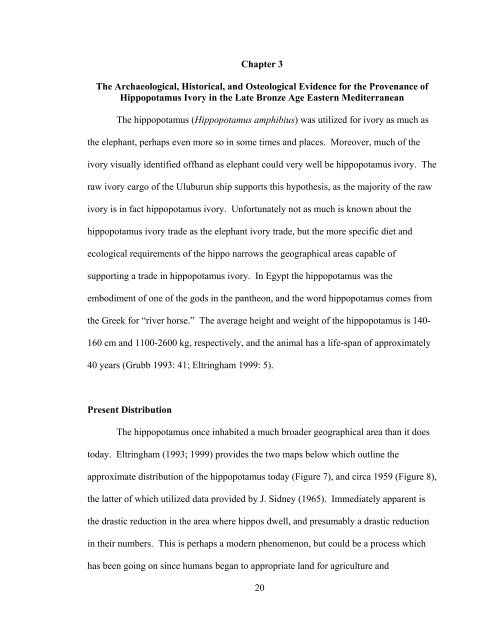Tracing the Source of the Elephant And Hippopotamus Ivory from ...
Tracing the Source of the Elephant And Hippopotamus Ivory from ...
Tracing the Source of the Elephant And Hippopotamus Ivory from ...
Create successful ePaper yourself
Turn your PDF publications into a flip-book with our unique Google optimized e-Paper software.
Chapter 3<br />
The Archaeological, Historical, and Osteological Evidence for <strong>the</strong> Provenance <strong>of</strong><br />
<strong>Hippopotamus</strong> <strong>Ivory</strong> in <strong>the</strong> Late Bronze Age Eastern Mediterranean<br />
The hippopotamus (<strong>Hippopotamus</strong> amphibius) was utilized for ivory as much as<br />
<strong>the</strong> elephant, perhaps even more so in some times and places. Moreover, much <strong>of</strong> <strong>the</strong><br />
ivory visually identified <strong>of</strong>fhand as elephant could very well be hippopotamus ivory. The<br />
raw ivory cargo <strong>of</strong> <strong>the</strong> Uluburun ship supports this hypo<strong>the</strong>sis, as <strong>the</strong> majority <strong>of</strong> <strong>the</strong> raw<br />
ivory is in fact hippopotamus ivory. Unfortunately not as much is known about <strong>the</strong><br />
hippopotamus ivory trade as <strong>the</strong> elephant ivory trade, but <strong>the</strong> more specific diet and<br />
ecological requirements <strong>of</strong> <strong>the</strong> hippo narrows <strong>the</strong> geographical areas capable <strong>of</strong><br />
supporting a trade in hippopotamus ivory. In Egypt <strong>the</strong> hippopotamus was <strong>the</strong><br />
embodiment <strong>of</strong> one <strong>of</strong> <strong>the</strong> gods in <strong>the</strong> pan<strong>the</strong>on, and <strong>the</strong> word hippopotamus comes <strong>from</strong><br />
<strong>the</strong> Greek for “river horse.” The average height and weight <strong>of</strong> <strong>the</strong> hippopotamus is 140-<br />
160 cm and 1100-2600 kg, respectively, and <strong>the</strong> animal has a life-span <strong>of</strong> approximately<br />
40 years (Grubb 1993: 41; Eltringham 1999: 5).<br />
Present Distribution<br />
The hippopotamus once inhabited a much broader geographical area than it does<br />
today. Eltringham (1993; 1999) provides <strong>the</strong> two maps below which outline <strong>the</strong><br />
approximate distribution <strong>of</strong> <strong>the</strong> hippopotamus today (Figure 7), and circa 1959 (Figure 8),<br />
<strong>the</strong> latter <strong>of</strong> which utilized data provided by J. Sidney (1965). Immediately apparent is<br />
<strong>the</strong> drastic reduction in <strong>the</strong> area where hippos dwell, and presumably a drastic reduction<br />
in <strong>the</strong>ir numbers. This is perhaps a modern phenomenon, but could be a process which<br />
has been going on since humans began to appropriate land for agriculture and<br />
20

















